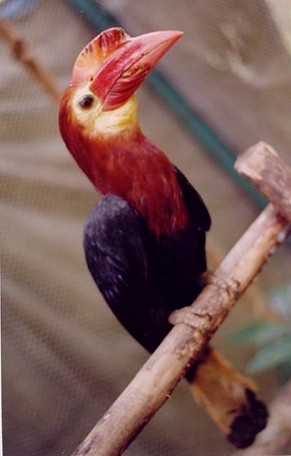|
| Query: bird | Result: 3725th of 32675 | |
Writhed-billed Hornbill (Aceros waldeni) - Wiki
| Subject: | Writhed-billed Hornbill (Aceros waldeni) - Wiki
| |

| Resolution: 291x456
File Size: 30642 Bytes
Upload Date: 2007:11:28 20:01:56
|
Writhed-billed Hornbill
From Wikipedia, the free encyclopedia
Order: Coraciiformes
Family: Bucerotidae
[Photo] Writhed-billed Hornbill (Aceros waldeni); Philippine Writhed-billed Hornbill. It is called "Dulungan" by the local people. Photo by Callan Bentley (http://www.callanbentley.com/).
The Writhed-billed Hornbill, or Visayan Wrinkled Hornbill (Aceros waldeni) is a hornbill bird living in the rainforests of Negros and Panay of the Philippines.
Status
This is a critically endangered species. Writhed-billed hornbills reproduce very slowly and thus are unable to survive high hunting pressures coupled with heavy logging of the rainforests. It is presumed extinct on Guimaras and now survives only on Negros and Panay. The current population is estimated at less than 160.
Habitat and behaviour
Rainforests with abundant fruit-bearing trees are the natural habitat of these birds. The writhed-billed hornbills live in small groups and are noisy.
Reproduction
Writhed-billed hornbills use natural or carved-out hollows in tree trunks for its nest. They reproduce very slowly. In conservation camps and parks, man made nests made of wooden boxes are being attached to tree trunks.
The binomial commemorates the Scottish ornithologist Viscount Walden.
http://en.wikipedia.org/wiki/Writhed-billed_Hornbill
| The text in this page is based on the copyrighted Wikipedia article shown in above URL. It is used under the GNU Free Documentation License. You may redistribute it, verbatim or modified, providing that you comply with the terms of the GFDL. |
|
Comments |
|---|
| | Guest |
|
Scientific Name: Aceros waldeni (Sharpe, 1877)
Common Names: Rufous-headed Hornbill, Walden's Hornbill, Writhed-billed Hornbill, Visayan Wrinkled Hornbill
French: Calao de Walden German: Waldenhornvogel Spanish: Cálao grande de Panay
Taxonomy: Craniorrhinus [sic] waldeni Sharpe, 1877, Panay, Philippines.
Synonyms:
Craniorrhinus waldeni Sharpe, 1877 [sic]
Rhabdotorrhinus waldeni (Sharpe, 1877)
Aceros leucocephalus waldeni |
^o^
Animal Pictures Archive for smart phones
^o^
|
|
|